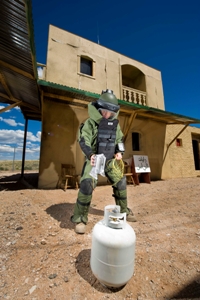Oct 18 2010
Sandia National Laboratories has won technology transfer awards for a water disruptor now diffusing improvised explosive devices in Afghanistan, mobile, fuel cell-powered lighting used at the 82nd Annual Academy Awards® and a national institute that teaches students cutting-edge nanoengineering.
The winners of the Federal Laboratories Consortium (FLC) Mid-Continent Regional Awards were honored recently in Jackson Hole, Wyo. They include the Sandia team that invented the water disruptor and licensed the technology to Albuquerque-based TEAM Technologies Inc.; a Sandia-led partnership that developed the fuel-cell lighting system; and a collaboration that created the National Institute for Nano Engineering (NINE) hosted at Sandia.
 Airman 1st Class Patrick Connolly of Dayton, Ohio, demonstrates the placement of a water disruptor developed at Sandia National Laboratories that has won a Federal Laboratories Consortium award for technology transfer.
Airman 1st Class Patrick Connolly of Dayton, Ohio, demonstrates the placement of a water disruptor developed at Sandia National Laboratories that has won a Federal Laboratories Consortium award for technology transfer.
“These exceptional projects highlight Sandia National Laboratories’ efforts to transfer its technologies outside the laboratory, whether to private companies to create jobs, to provide technical solutions where they’re needed or through educating our college students and readying them for future science or engineering careers,” said Jackie Kerby Moore, Sandia’s manager of Technology & Economic Development.
Sandia’s water disruptor, which shoots a blade of water capable of penetrating steel to safely diffuse improvised explosive devices (IEDs), won an Excellence in Technology Transfer Award after the technology was licensed to TEAM, a small minority-owned business.
The company has marketed the device as the Stingray, and has sent about 7,000 water disruptors to Afghanistan and military training sites since July.
The collaboration between TEAM, a company of 75 employees located in the Sandia Science & Technology Park, and Sandia enabled the water disruptors to be delivered seven months after the licensing agreement was signed.
TEAM also plans to sell the water disruptor to law enforcement and airport security agencies.
A 14-partner team of technology holders, manufacturers and end users led by Sandia won a Notable Technology Development Award for a Fuel Cell Mobile Light. Sandia, Boeing Co., the California Department of Transportation, Altergy Systems, Stray Light Optical Technologies, Multiquip Inc. and other partners developed the system as a clean, efficient alternative to traditional technologies powered by diesel fuel generators.
In March, the lighting system lit the construction of the famed red carpet area and an entrance to the red carpet used by the international press corps and production personnel and powered a security portal at the Academy Awards ceremony in Hollywood.
Using funding from DOE’s Office of Energy Efficiency and Renewable Energy and Boeing, the project is constructing six “near-commercial” units that will be subjected to rigorous environmental and performance testing in order to finalize the commercial design. The team hopes to offer the unit for sale by late this year or early next year.
Finally, the National Institute for Nano Engineering (NINE) received the Science Technology, Engineering and Mathematics (STEM) Education Award for its public-private partnership of government, industry and universities that brings college students and faculty to its facility to focus on developing nanoengineering solutions to national problems.
NINE was established as a national innovation hub for nanoengineering three years ago, and is the only such program in the U.S. It provides nanoengineering solutions to meet Sandia’s mission and real-life, large-scale nanoengineering research opportunities for students and faculty. The institute has a collaborative environment that matches students with Sandia and industry mentors and motivates top undergraduates to obtain advanced degrees.
This year, for the first time, Sandia and its industrial and university partners together selected the technical projects that will receive more than $9 million in research and development funding and will be NINE’s focus for several years. The projects will provide research opportunities for 36 graduate students.
The three winners were selected from an FLC region that is home to more than 100 federal laboratories in 14 states: Arkansas, Colorado, Iowa, Kansas, Missouri, Montana, Nebraska, New Mexico, North Dakota, Oklahoma, South Dakota, Texas, Utah and Wyoming.
Source: http://www.sandia.gov/